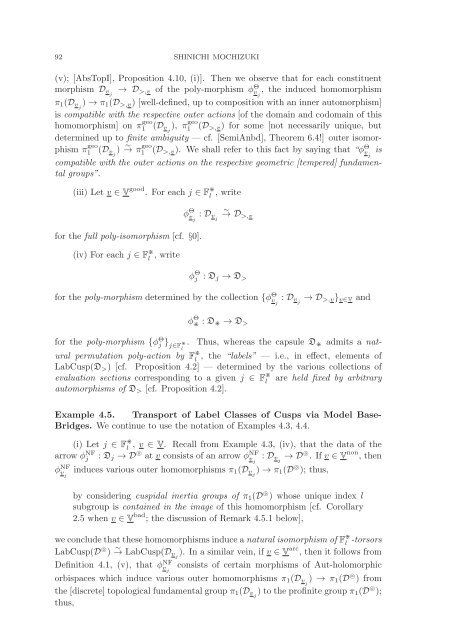Inter-universal Teichmuller Theory I: Construction of Hodge Theaters
Inter-universal Teichmuller Theory I: Construction of Hodge Theaters
Inter-universal Teichmuller Theory I: Construction of Hodge Theaters
You also want an ePaper? Increase the reach of your titles
YUMPU automatically turns print PDFs into web optimized ePapers that Google loves.
92 SHINICHI MOCHIZUKI<br />
(v); [AbsTopI], Proposition 4.10, (i)]. Then we observe that for each constituent<br />
morphism D vj → D >,v <strong>of</strong> the poly-morphism φ Θ v j<br />
, the induced homomorphism<br />
π 1 (D vj ) → π 1 (D >,v ) [well-defined, up to composition with an inner automorphism]<br />
is compatible with the respective outer actions [<strong>of</strong>thedomainandcodomain<strong>of</strong>this<br />
homomorphism] on π geo<br />
1 (D vj ), π geo<br />
1 (D >,v ) for some [not necessarily unique, but<br />
determined up to finite ambiguity — cf. [SemiAnbd], Theorem 6.4!] outer isomorphism<br />
π geo<br />
1 (D vj ) ∼ → π geo<br />
1 (D >,v ). We shall refer to this fact by saying that “φ Θ v j<br />
is<br />
compatible with the outer actions on the respective geometric [tempered] fundamental<br />
groups”.<br />
(iii) Let v ∈ V good .Foreachj ∈ F l ,write<br />
for the full poly-isomorphism [cf. §0].<br />
φ Θ v j<br />
: D vj<br />
∼<br />
→D>,v<br />
(iv) For each j ∈ F l ,write φ Θ j : D j → D ><br />
for the poly-morphism determined by the collection {φ Θ v j<br />
: D vj →D >,v } v∈V and<br />
φ Θ : D → D ><br />
for the poly-morphism {φ Θ j } j∈F . Thus, whereas the capsule D admits a natural<br />
permutation poly-action by F l<br />
l<br />
, the “labels” — i.e., in effect, elements <strong>of</strong><br />
LabCusp(D > ) [cf. Proposition 4.2] — determined by the various collections <strong>of</strong><br />
evaluation sections corresponding to a given j ∈ F l<br />
are held fixed by arbitrary<br />
automorphisms <strong>of</strong> D > [cf. Proposition 4.2].<br />
Example 4.5. Transport <strong>of</strong> Label Classes <strong>of</strong> Cusps via Model Base-<br />
Bridges. We continue to use the notation <strong>of</strong> Examples 4.3, 4.4.<br />
(i) Let j ∈ F l<br />
, v ∈ V. Recall from Example 4.3, (iv), that the data <strong>of</strong> the<br />
arrow φ NF<br />
j : D j →D ⊚ at v consists <strong>of</strong> an arrow φ NF<br />
v j<br />
: D vj →D ⊚ .Ifv ∈ V non ,then<br />
induces various outer homomorphisms π 1 (D vj ) → π 1 (D ⊚ ); thus,<br />
φ NF<br />
v j<br />
by considering cuspidal inertia groups <strong>of</strong> π 1 (D ⊚ ) whose unique index l<br />
subgroup is contained in the image <strong>of</strong> this homomorphism [cf. Corollary<br />
2.5 when v ∈ V bad ; the discussion <strong>of</strong> Remark 4.5.1 below],<br />
we conclude that these homomorphisms induce a natural isomorphism <strong>of</strong> F l -torsors<br />
LabCusp(D ⊚ ) → ∼ LabCusp(D vj ). In a similar vein, if v ∈ V arc , then it follows from<br />
Definition 4.1, (v), that φ NF<br />
v j<br />
consists <strong>of</strong> certain morphisms <strong>of</strong> Aut-holomorphic<br />
orbispaces which induce various outer homomorphisms π 1 (D vj ) → π 1 (D ⊚ )from<br />
the [discrete] topological fundamental group π 1 (D vj ) to the pr<strong>of</strong>inite group π 1 (D ⊚ );<br />
thus,
















